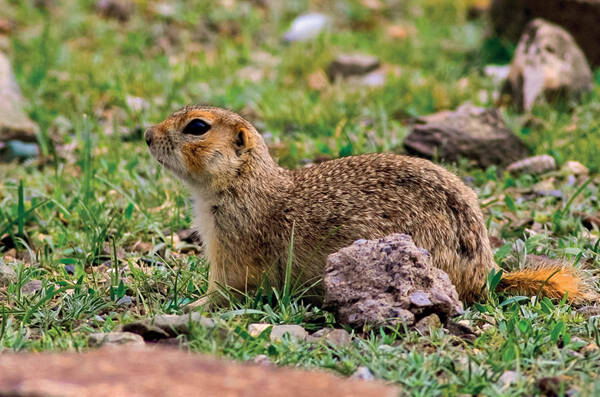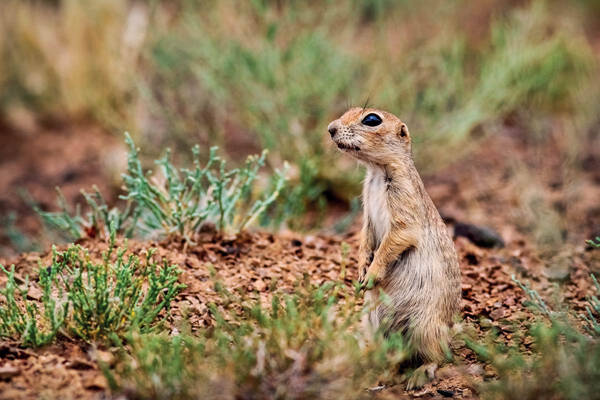Spermophilus erythrogenys
IUCN
LCBasic Information
Scientific classification
- name:Spermophilus erythrogenys
- Scientific Name:Spermophilus erythrogenys,Red-cheeked Ground Squirrel,Pale-tailed yellow squirrel
- Outline:Rodents
- Family:Rodentia Sciuridae Squirrel
Vital signs
- length:Approx. 258 mm
- Weight:
- lifetime:
Feature
The back of the body from the top of the head to the base of the tail is sandy yellow, or grayish yellow with gray-black tones.
Distribution and Habitat
In China, it is distributed in northern Xinjiang and Inner Mongolia. Abroad, it is distributed in Russia, Kazakhstan, and Mongolia.
It lives in grasslands and deserts and is active mainly during the day.
Appearance
The body is medium in size. The top of the head is relatively dark in color, with an eyebrow spot above the eye and a wide reddish-brown cheek spot below the eye. The back of the body is mainly yellow-brown with a darker grayish-yellow color. The tips of the hair are slightly lighter, forming small spots on the back. Some individuals have a sandy yellow or rusty yellow back with orange-red. The abdomen is yellow. The back of the feet is khaki or dirty white. The back of the tail is khaki-gray, and the belly is rusty yellow.
Details
Red-cheeked yellow squirrel is an animal of the Sciuridae family and the genus Squirrel. It inhabits low mountain grasslands, piedmont hilly grasslands and semi-desert plains. In some places, it can rise along the river valley to the mountain grasslands of the mid-mountain belt at an altitude of 1,500 meters.
Red-cheeked yellow squirrel is a daytime rodent. Its hearing, vision and smell are very sensitive and vigilant. Before leaving the cave, it looks around at the entrance of the cave to observe the movement. If it encounters suspicious objects or danger signals, it immediately makes a short and single "squeak". After informing its peers, it quickly escapes into the cave. Weather changes have a certain impact on its activities. Generally, when there is no wind, it is sunny and the temperature is high, it is active frequently, and the time it spends on the ground can sometimes reach 220 minutes. When it encounters rainy weather, the activity weakens, and even moves from low to high. When there is a strong wind of more than level 7, it rarely leaves the cave. There are frequent activities from 8 am to 6 pm in mid-May, especially at 12-14 noon, with a peak activity. There are few activities in the morning and evening, and no activities at night. The activity range generally does not exceed 30 meters, but sometimes it can reach more than 40 meters.

The hibernation period of the red-cheeked yellow squirrel is related to the local temperature. Generally, they come out of hibernation in mid- to late-March and enter hibernation in late September. In areas where the temperature is high in summer and plants wither and turn yellow early, summer hibernation may occur. The time of summer hibernation starts from the beginning of July when the young mice separate and continues until hibernation.
The caves of red-cheeked yellow mice are mostly scattered at the foot of the sunny slopes of hills, valleys and both sides of streams. The diameter of the cave entrance is about 5 cm. The total length of the living cave is 3-5 meters, with few branches, nests, and mostly one cave entrance. The temporary cave is short and shallow, with no nests and no branches. When the young mice separate, they often convert the temporary cave into a living cave. The hibernation hole is deep, and the hibernation nest is usually less than 2 meters. When hibernating, a section of the hibernation hole is blocked to facilitate safe wintering.
Red-cheeked yellow squirrel likes to eat green parts of plants, flowers, fruits, tubers and a small amount of coleoptera insects. In agricultural areas, it also eats young stems and leaves of wheat, beans and alfalfa. In early spring, it mainly feeds on the rhizomes of dead grass, and in autumn, it also eats a small amount of seeds.

Red-cheeked yellow squirrels reproduce only once a year. After hibernation, the mice emerge from hibernation at the end of March and soon enter the mating period. During the mating period, male and female mice frequently burrow into holes and are extremely active. Red-cheeked yellow squirrels usually live alone in a single room, but at this time they can often be found in a hole. The mating period lasts from early April to the end of April, about 3 weeks. At this time, pregnant mice, mice with vaginal plugs in the reproductive tract and mice in the ovulation period can be seen at the same time, and the sex ratio is basically 1:1; infertile mice account for about 10% of all female mice. The mating-gestation period of the population (about from mid-to-late April to the end of May in Inner Mongolia) is about 50 days, and the gestation period is 28-30 days. The birthing period is concentrated from early May to the end of the month. All pregnant mice give birth in early June, which takes 4 weeks. The number of litters is 2-10, and the most common is 4-7. The uterine spots left in the uterus of pregnant mice after giving birth disappear before hibernation. The time when the young mice separate from the mother mouse is generally concentrated in late June, but the earliest young mice to leave the nest may be in early June.
In my country, the population fluctuation of red-cheeked yellow squirrel belongs to a relatively stable type, with little change between years, and only differences in different habitats.








